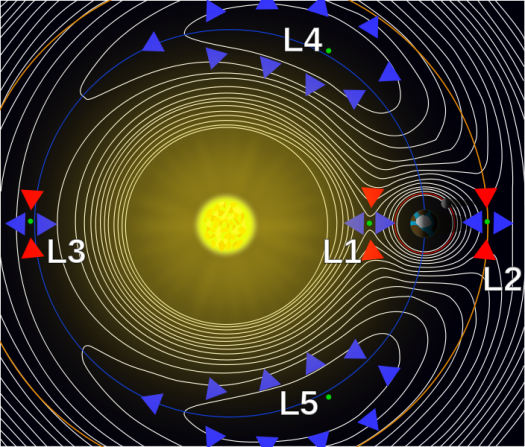NASA has announced the award-winners of its Innovative Advanced Concepts (NIAC) Program, in which the agency gives funding to projects that are a little more, uh, ambitious than usual. (One previous candidate: satellites that beam energy down to Earth.) This year’s proposals are pretty wild, too (suspended animation! perpetual flight!), and they’re getting a one-year advance of $100,000 to prove the plans have some merit. After that, they’ll be re-considered for Phase II study, which would mean $500,000 for two years. Here’s what they’ve got in mind.
Suspended Animation
It’d be great if astronauts could lie down in a rocket, take a little nap, and wake up on Mars, but we haven’t been able to reach the dream of suspended animation–where space-travelers can stay unconscious but healthy–yet.And we’re still a ways off. But NASA is giving money to aerospace firm SpaceWorks Engineering to imagine what that future might look like, providing “an end-to-end Mars mission architecture” for the project. That pod you see would be the “torpor-inducing transfer habitat,” i.e. the place where you doze off until Mars. The future looks… cramped.
Fission-Fusion Propulsion
Fusion power, energy created from two atomic nuclei combining, still isn’t quite a dependable energy source. But combined fusion-fission power systems, where a reaction between both is used as a source of power, have been around in weapons since the 1950s. This proposal wants to take that idea and (putting this broadly) scale it up, sending the energy out a funnel for thrust to launch a rocket. The creators say the project “would provide a radical improvement in our ability to explore destinations across the solar system and beyond.”
2-D Space Landers
Ah, perhaps finally the ideas first proposed by the creators of Space Invaders will come true: flat space landers. The proposal–which basically calls for Mars kites–would start out with a series of flat panels strung together, then a spacecraft would drop the panels while flying near planets. On board each of the landers would be “a variety of planet/body probing sensors, power generators, associated avionics, and telecommunications capability,” the creators say. Plus: fun for Martian children to play with.
Solar System CubeSats
CubeSats, the small, boxy satellites that can be cheaply sent into orbit, haven’t done much exploring outside of Earth’s vicinity, since they usually just hitch a ride on rockets heading for space. But a different propulsion system could shoot them into more far-flung parts of the solar system. This proposal suggests using a combined thermal and electric propulsion system to ferry the satellites to other planets, which would be a heck of a lot cheaper than creating a full-blown spaceship.
Space Pit Stop
This proposal suggests building an orbiting structure on the far side of the moon, which would provide “water for shielding, irrigation and life support, soil for ecosystem development, and to enable structural maintenance and enhancement.” It actually isn’t the first project of the sort we’ve seen, but it’s still a long way off, considering the far side of the moon is the farthest we’ve ever sent a manned space craft.
Perpetual flight
Perpetual flight refers to a plane that, theoretically, glides for years without ever needing to touch the ground. It’s the future (we said so)! This plan differs from others in that it would reduce the plane’s drag and structural weight by 50 percent each.
Asteroid Mapping
It’s possible to make maps of things like volcanos from a distance by monitoring how the volcanoes interact with galactic rays–so why not do it for asteroids? One proposal suggests creating new “spacecraft instrumentation, data analysis, and imaging methods” to take a deeper look at asteroids and comets. The info could be useful to scientists, and the authors say such a project would be “necessary for the development of planetary defense strategies.” Perhaps some of the funding could also go to Bruce Willis.
Bio-Printing
One thing about Mars: it’s short on grocery stores. But what if, instead of hauling food and supplies on board a ship, space-travelers could print food, and even human tissue, on demand? NASA has funded that idea, as we’ve mentioned before, and it’s included in this batch of projects. Yum.
More Maneuverable Satellites
Small (and by extension cheaper) spacecraft could be useful for NASA missions, but there’s one problem: the crafts’ current propulsion systems make them hard to maneuver. One proposal’s solution is to use plasmonics, a field of nanophysics, to minutely power craft, “enabling NASA science and exploration missions that were previously impossible.”
High-Tech Rover Buddies
To get the most out of rovers like Curiosity, one proposal suggests using “TransFormers,” shapeshifting platform-‘bots that can help on missions. “Unfolding to large areas, they can reflect solar energy, warming and illuminating targets, powering solar panels, tracking movement and acting as a telecommunications relay,” the proposers say. Nice. It probably gets lonely on Mars.
Balloon Telescope
Here’s a mix of new and not-so-new tech: a telescope that “consists of an inflatable, half-aluminized spherical reflector deployed within a much larger carrier balloon–either zero pressure or super pressure. “The sub-orbital balloon-a-scope could look out to space, or turn inward toward earth for “remote sensing or telecommunication activities.” Very Jules Verne.
Slimmer Satellite
Instead of loading satellites with relatively bulky sensors, this project wants to use advances in optics to create sensors made through millions of “white-light interferometers,” which pick up on invisible waves. The resulting machines would give NASA lower-mass alternatives for, say, space telescopes.












